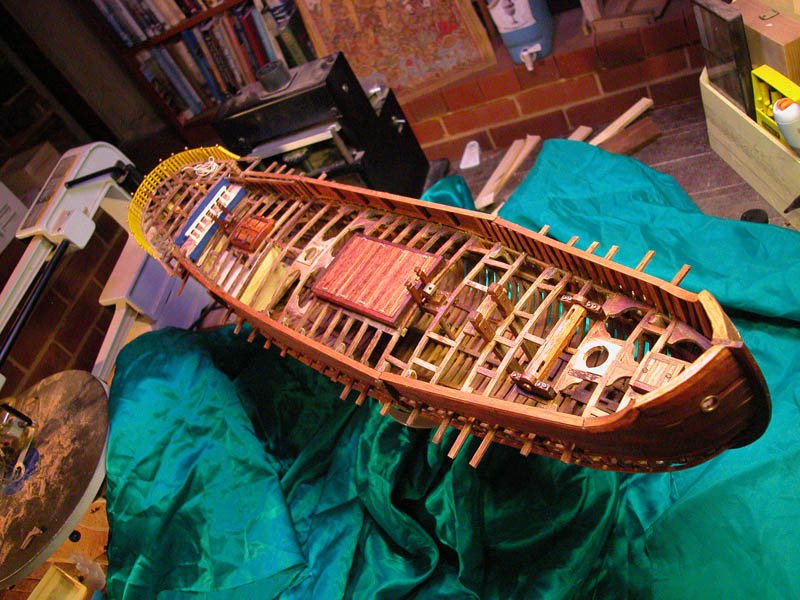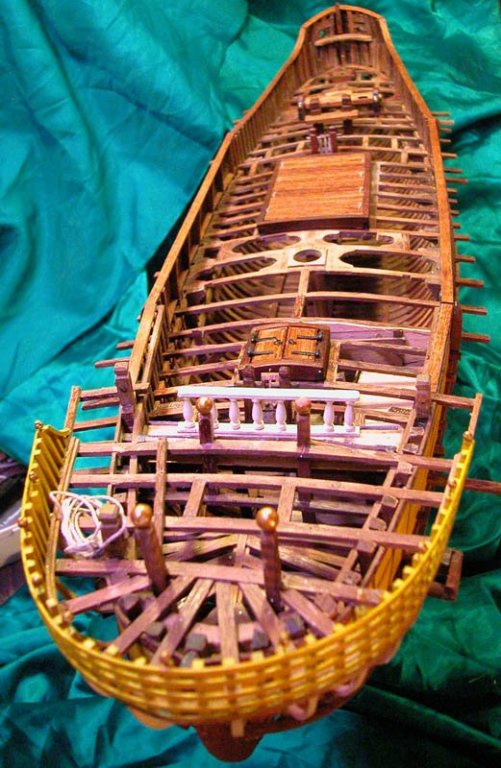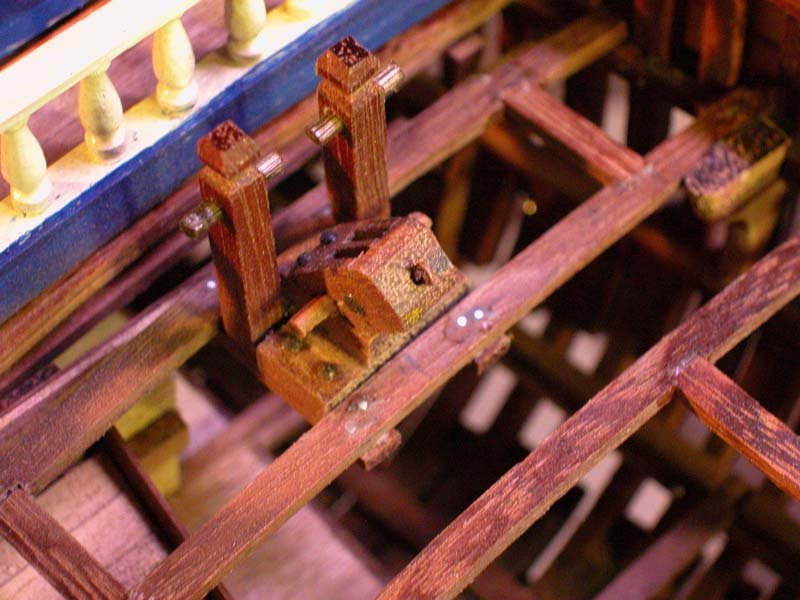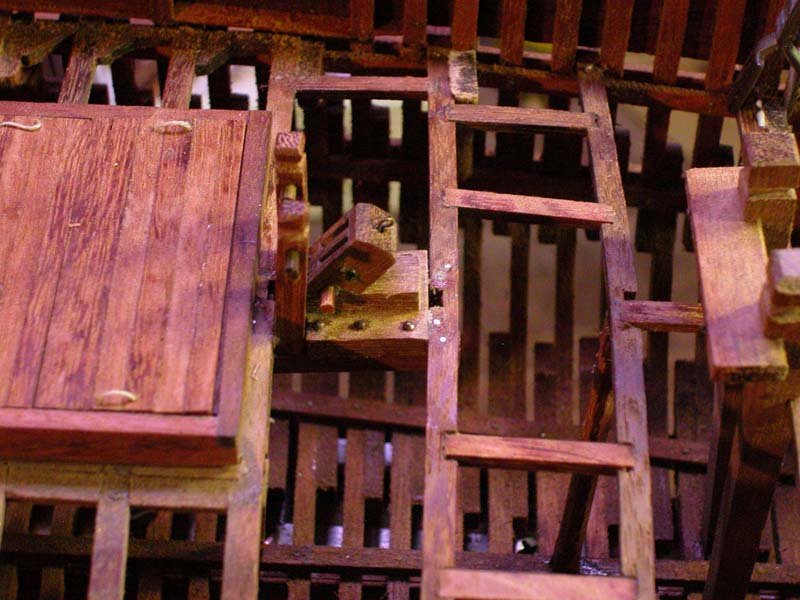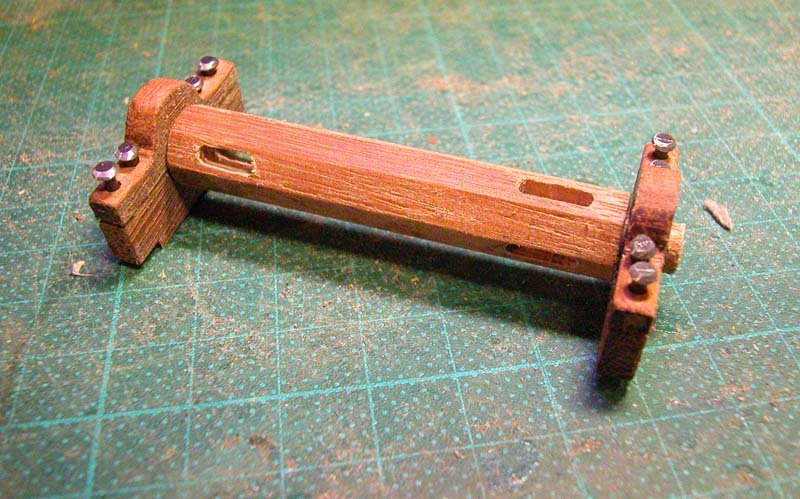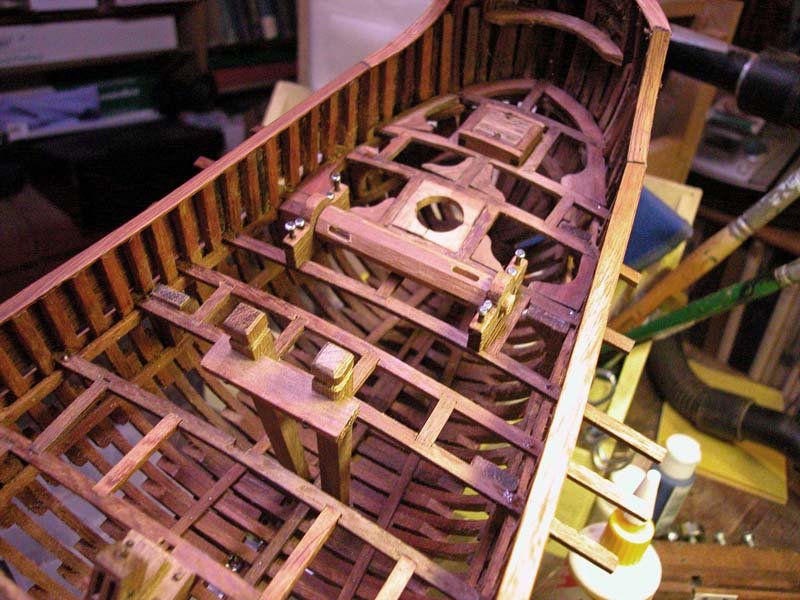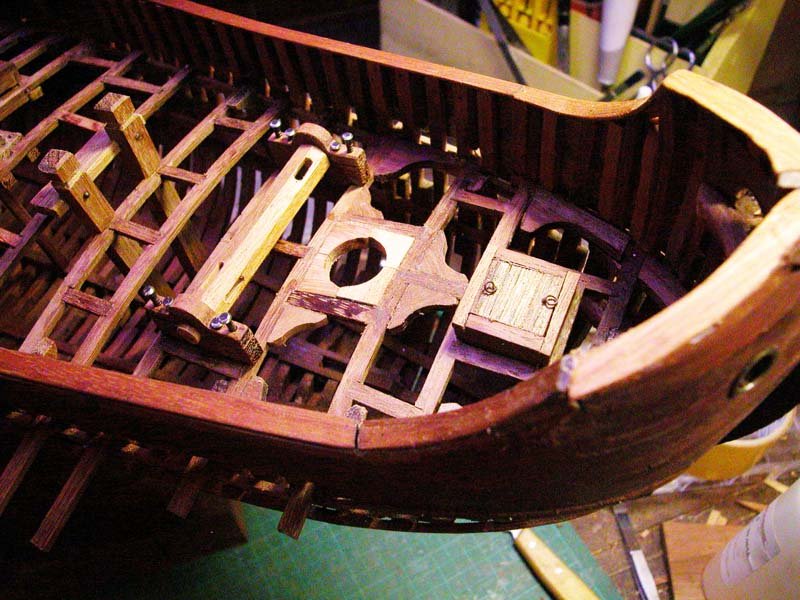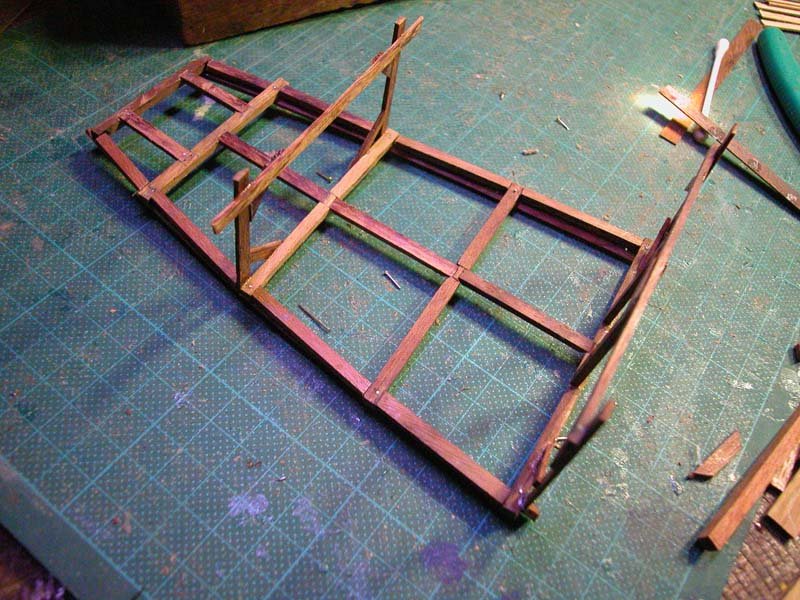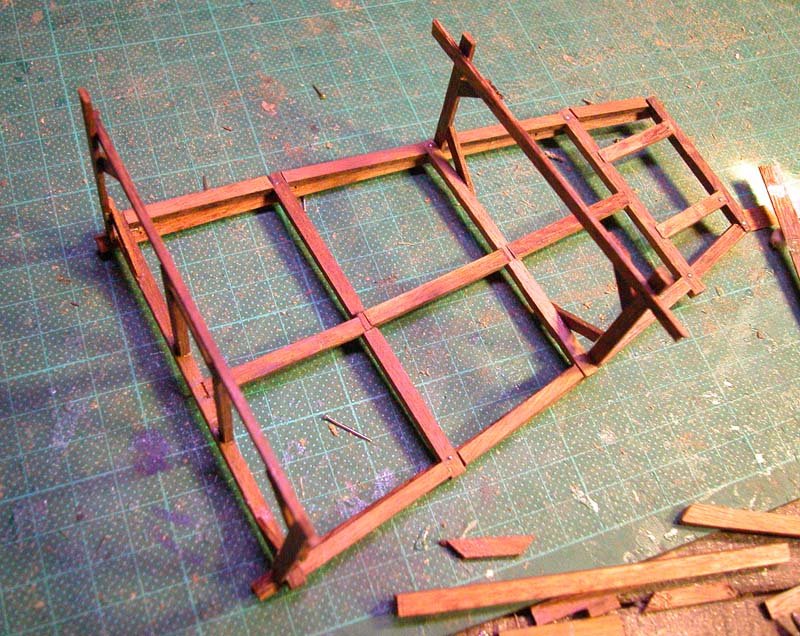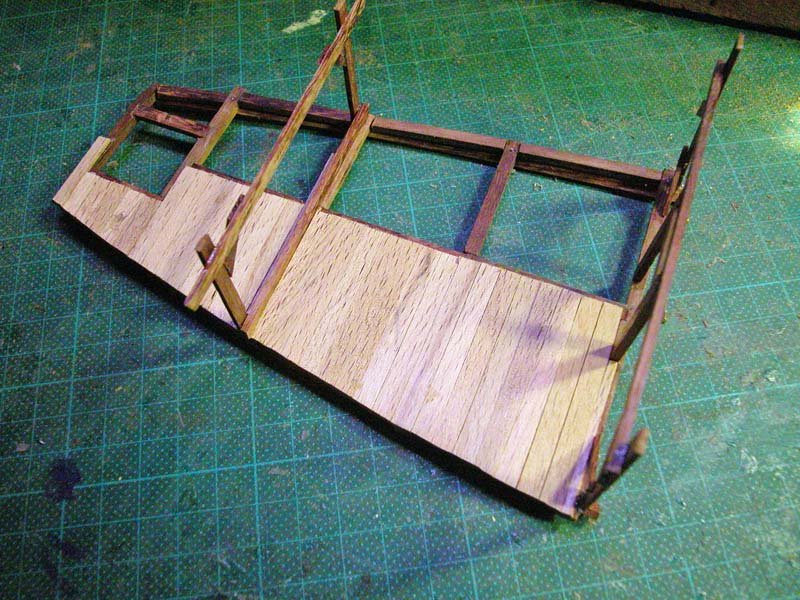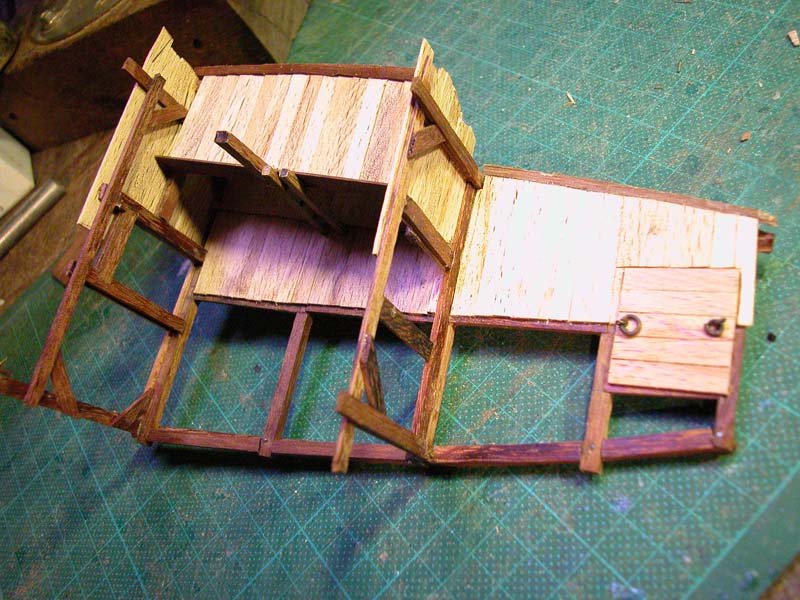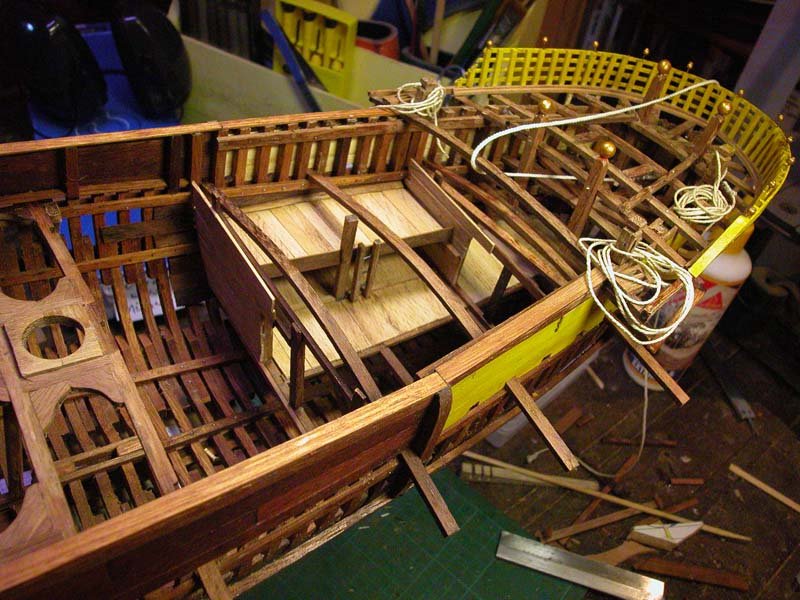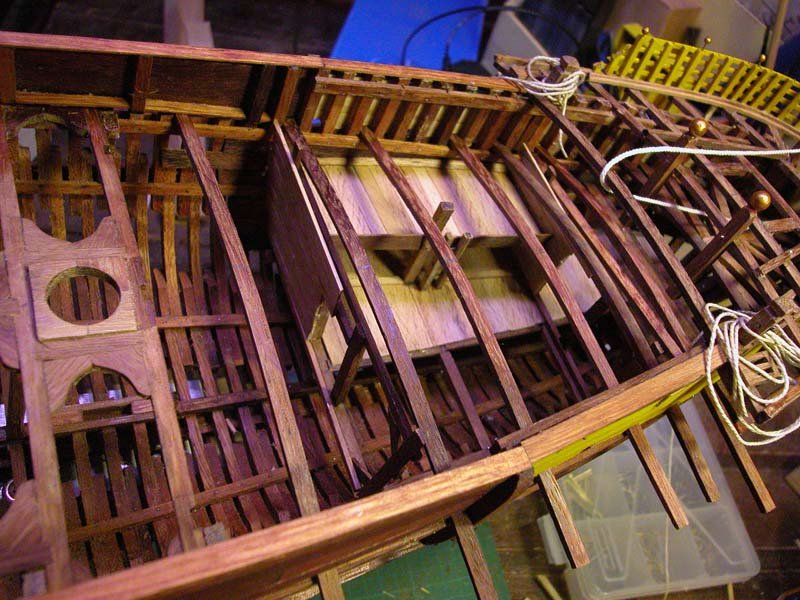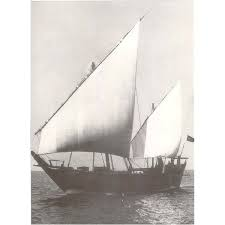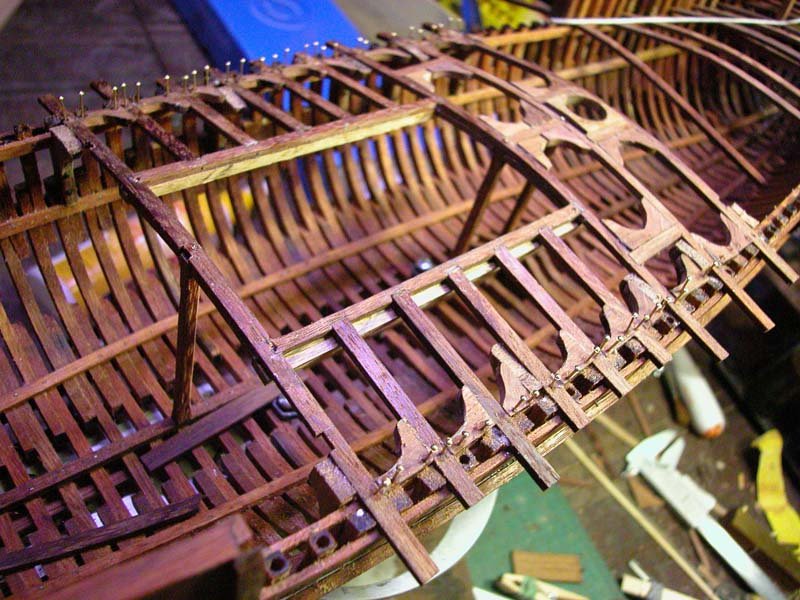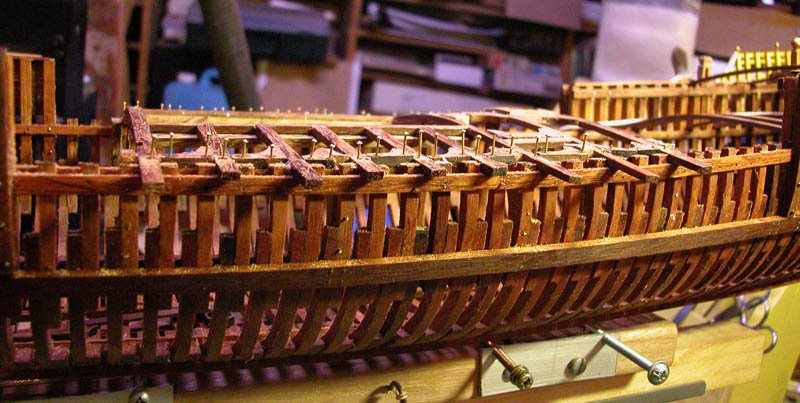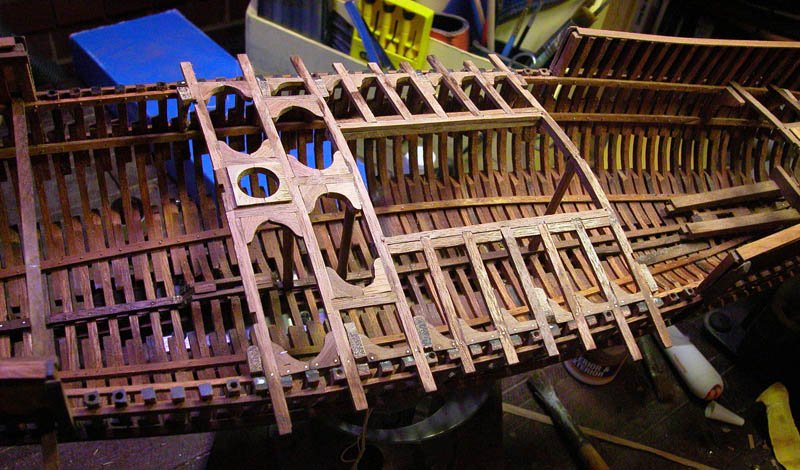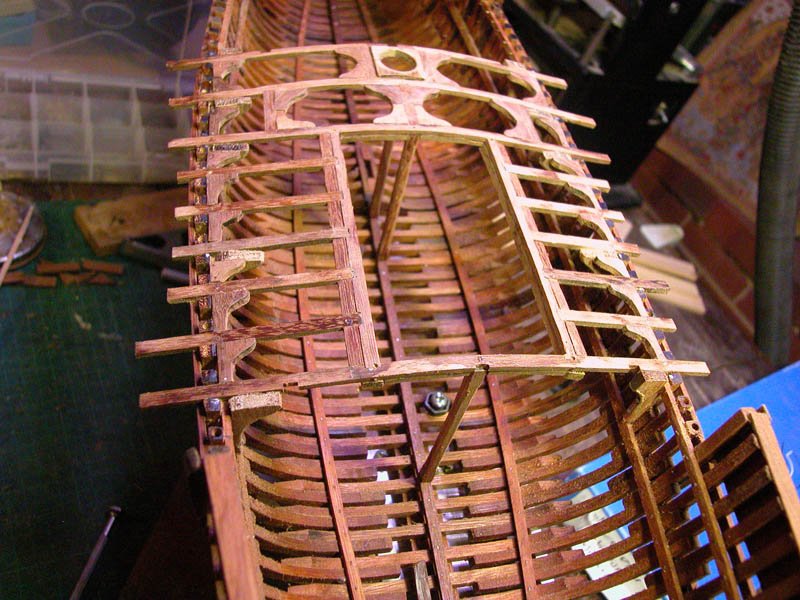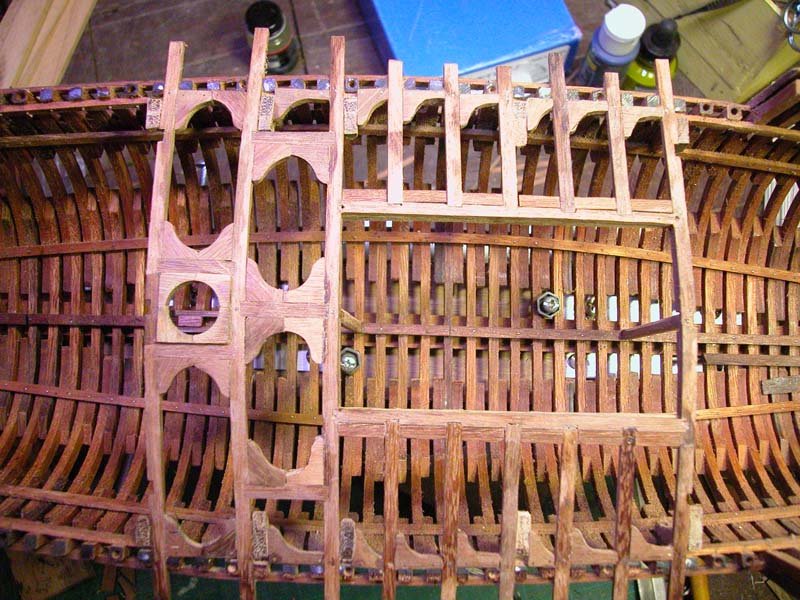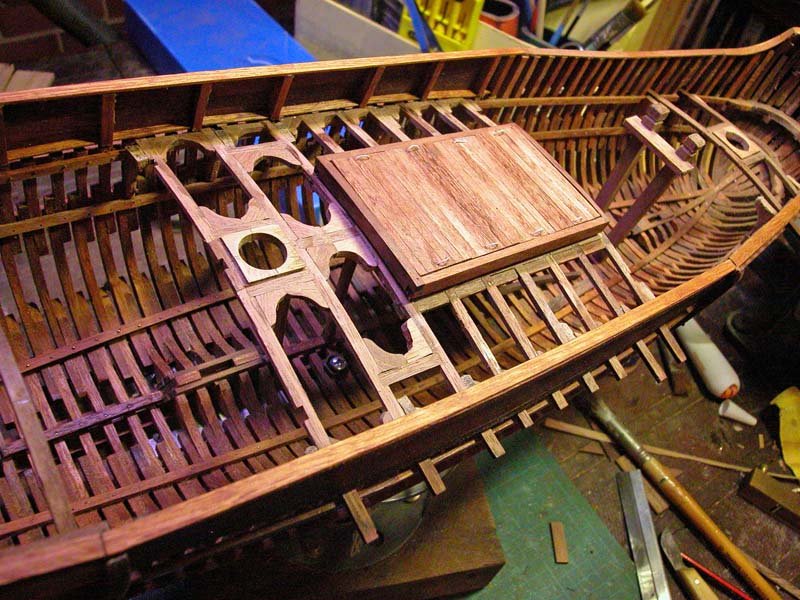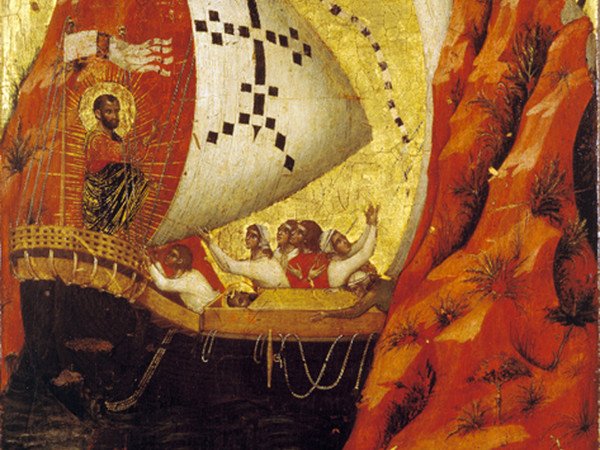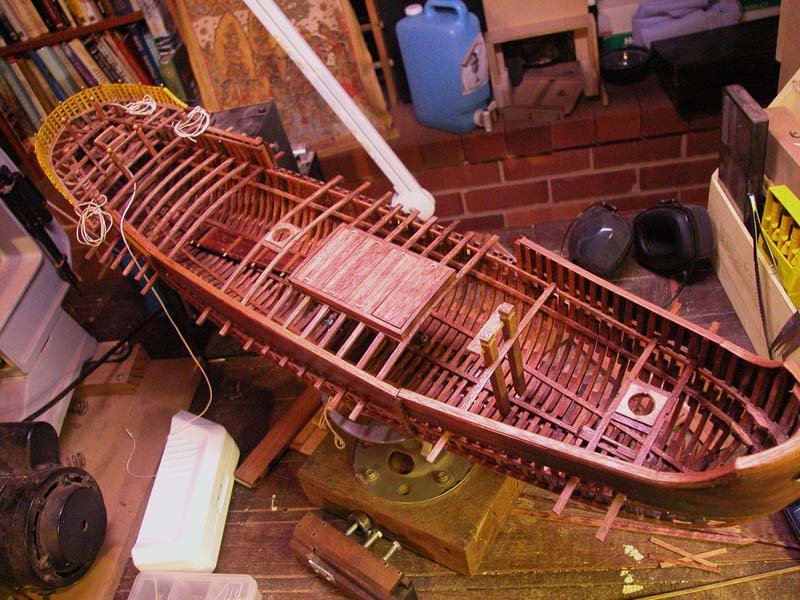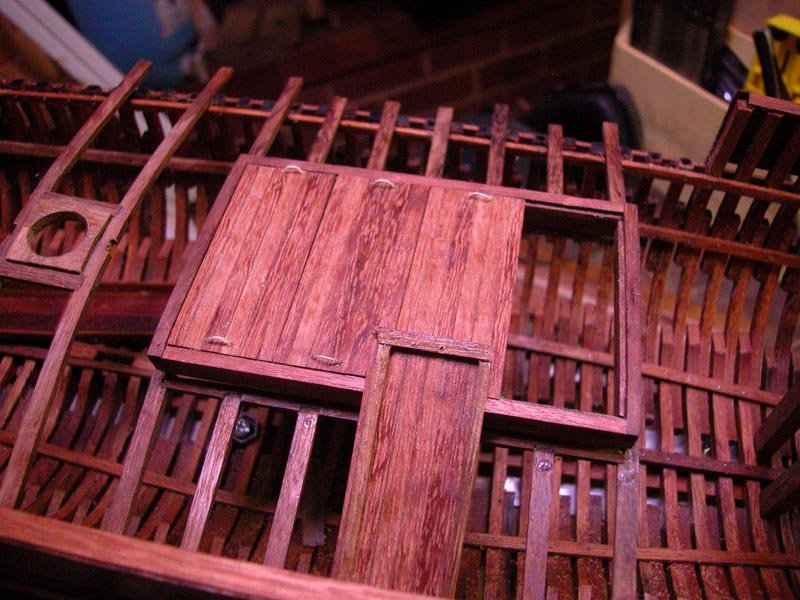-
Posts
834 -
Joined
-
Last visited
Content Type
Profiles
Forums
Gallery
Events
Everything posted by woodrat
-
Thanks Yancovitch and everyone else for all the likes. The hull framing is directly taken from the comprehensive excavation of a wreck from the Po delta called the Contarina 1. the master frame is taken from a contemporary manuscript, the Libro di Navigar ( see earlier posts for details). As for deck framing, the deck machinery and hatches follow logically from the position of masts but are largely a matter of speculation, especially the knees. No claim is made for this vessel to be anything but a product of my imagination. Steven, thanks for the calcet details. This will be useful. I haven't thought about it yet but there is also the problem of the basket aft of the masthead and the Jacob's ladder to be considered. The Lomellina was a square rigged nave wasn't she? Perhaps this calcet can be adapted for latin rig. Cheers Dick
- 263 replies
-
- nave tonda
- round ship
-
(and 2 more)
Tagged with:
-
As requested, some overall views showing deck furniture. All that is remaining is the log pumps. Still not sure whether to plank half the deck The companionway to the aft accommodation. Ladder to be added. Cheers Dick
- 263 replies
-
- nave tonda
- round ship
-
(and 2 more)
Tagged with:
-
Soon to come, Steven, but will do so in a day or so after more additions to deck furniture. Dick
- 263 replies
-
- nave tonda
- round ship
-
(and 2 more)
Tagged with:
-
My concept of the lower halyard blocks and bitts for the two masts. Loosely based on a Black sea find. On contemporary iconography a consistent feature is the halyard angling acutely aft from the mast as is the practice in dhows. This also allowed the halyards to act like backstays. Cheers Dick
- 263 replies
-
- nave tonda
- round ship
-
(and 2 more)
Tagged with:
-
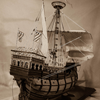
Unique 500 year old shipwreck in the Baltic sea
woodrat replied to mic-art's topic in Nautical/Naval History
Beautifully preserved wreck and a log pump AND capstan in situ. Wow! Note the transom timber at the stern with a round tuck stern and she is carvel. Not what I would expect from a northern ship of the era. that foremast is very forrard and stepped on the stempost. Fascinating find! Dick -
Thanks. Carl. Just call me Simplicius. 😎
- 263 replies
-
- nave tonda
- round ship
-
(and 2 more)
Tagged with:
-
Yes, Steven. I made it octagonal for 3 reasons: The slots for the levers are on alternative facets, lessening risk of weakening the log. When winding, it allows the winders on the opposite side to maintain the strain while the next lever is inserted. Thereby a rhythm is set up, no doubt with a shanty to go with it . It looks good. Dick 😎
- 263 replies
-
- nave tonda
- round ship
-
(and 2 more)
Tagged with:
-
I have made a simple windlass which is likely to be what they used in the 13th century. No pawls are needed as the windlass could be prevented from running backwards simply by one of the crew pushing his lever all the way through to the other side, effectively locking it. Cheers Dick
- 263 replies
-
- nave tonda
- round ship
-
(and 2 more)
Tagged with:
-
I am happy to help if I can. Don't be too discouraged if it all seems daunting. My first ship model "USF Essex " was way above my head but I took the time, researched the build and bought or made the tools. It took me 10 years but was worth it. Be prepared to modify the kit if it is inadequate or inaccurate. I have all the info you would need to make your model carrack as historically accurate as is possible. Don't be in a hurry. I look forward to your build. Cheers Dick
-
do you have a reference for this chain pump? I would have thought that simple log pumps would have been used at this time. Dick
-
It occurred to me that there should be accommodation in the after part of the ship for passengers and ship's master/pilot. Bit difficult to do it at this stage but I thought it important. So I retrofitted the quarters. Very basic accommodation (and no doubt cramped and smelly). The planking is only on the starboard side. I think there would be capacity for about 20 passengers in the steerage Dick
- 263 replies
-
- nave tonda
- round ship
-
(and 2 more)
Tagged with:
-
The mediaeval lateen rig had the sail OUTSIDE the shrouds so if your caravel friend is putting the sail aback against the mast , he must have the sail INSIDE the shrouds which is counter to mediterranean practice of the period you are dealing with ( see prof. Pryor's publications on the mediaeval lateen rig). I will try to get hold of Julian Whitewright's thesis on the mediaeval lateen rig as a basis for the rig of my round ship. The dhows mostly used a settee sail not a full lateen and so I would be cautious using dhows as a model for your rig. It is no longer accepted that lateen rig originated in the Indian Ocean as undoubted depictions of lateen sail rigs date from the second century CE. the settee sail had the forward corner of the sail squared off Your idea of goose-winging the sails while oars are deployed is good. The oars would provide some lateral stability when running before the wind. I am enjoying the build immensely. Keep up the good work Dick
-
In order to tack the mediaeval lateener, it was necessary to bring the yard vertical against the mast. I think your crutch forward of the foremast would impede that manoeuvre. Also the lower part of the yard needs to be shorter than the upper so it can clear the forecastle. The best illustrations of this manoeuvre are in Landstrom's "`The Ship". If you are going to depict rowers, are you going to stow the yards on the crutches? Dick
-
Carl, I have no idea. Wrecks of this period have no decks. The Black sea may tell us in time. At the end of the day, if I am not happy, I can fully plank the deck. There must have been some method of strengthening the deck around the mast partners and bitts to allow transmission of force. Dick
- 263 replies
-
- nave tonda
- round ship
-
(and 2 more)
Tagged with:
-
Here is the framing of the mid portion of the deck including hatch and mizzen mast partner. It is largely guesswork but I can assure you it is quite strong. Dick
- 263 replies
-
- nave tonda
- round ship
-
(and 2 more)
Tagged with:
-
with regard to the "horns" at the stern, they are consistently shown with round knobs on top. This seems to suggest that the yards could be lashed to the horn, obviating the need for a cross piece. I agree that in port they may have just used removable crutches. Smaller vessels may have taken yards and unstepped the masts, stowing them along the side as seen in the Breydenbach vessel on the left. Dick
- 263 replies
-
- nave tonda
- round ship
-
(and 2 more)
Tagged with:
-
Love the crutches but I still think your spur is too long😓. But as long as you are happy with it, thats all that matters. Interestingly the undoubted dromons shown on the Annales de Genes show the spur well. These are not dromons as there is only a single bank of oars Dick 😊
-
The yards were too long to stow on deck and in the case of galleys, would get in the way of oarsmen. Lowered yards could also be used to drape awnings when in harbour. Here is a picture from Breydenbach's Peregrinatio in Terram Sanctam 1486 (artist Reuwich) showing a small trading vessel being loaded through a removable bulwark. Note that quarter rudders are used with a swing mount but have been removed while in port. Note also that the other vessel has a massive stern rudder which would be very difficult to unship. Dick
- 263 replies
-
- nave tonda
- round ship
-
(and 2 more)
Tagged with:
-
Thanks, Steven. I know this drawing well as it was used on the cover of prof. Pryor's book "Geography, technology and war" . Required reading for anyone interested in the maritime history of the mediterranean in the mediaeval period I agree that the "horns" at the transom are wrongly drawn. They are probably meant to be lashed to the lowered yard. Question: When the yard was lowered, in the absence of horns, what did the yards rest on? Removable crutches? Alberto. I have reviewed all my images of the Black Sea vessel and I agree that there is definitely a gap in the starboard bulwark which is likely where a removable bulkhead was sited. I have put them on both port and starboard sides.. Cheers Dick
- 263 replies
-
- nave tonda
- round ship
-
(and 2 more)
Tagged with:
-
Thanks, Alberto. The Laurons ship was one of the factors that persuaded me that removable bulwarks were often used. In addition the veneziano painting on which I base my reconstruction seems to show the coffin of St Mark being loaded across a gap in the bulwarks: I will have to closely look at that feature on the Black Sea vessel you have pointed out. Well spotted. Dick
- 263 replies
-
- nave tonda
- round ship
-
(and 2 more)
Tagged with:
-
Including the coamings it is 67mm. equating to 2.14 metres which is 6.2 venetian piede Dick
- 263 replies
-
- nave tonda
- round ship
-
(and 2 more)
Tagged with:
-
I am unaware of when gratings made their first appearance but have seen no evidence of them in the mediaeval period or earlier. Dick
-
Steven. I found that tapering the wedges slightly from the outside to the inside allowed them to fit together more snugly. Then they are woolded. The dromon is looking fine. Too late to use it as a bread basket.😊 Dick
-
I suppose so. All is supposition until I get some answer from the archaeologists. I have been unable to find pictures of hatches from contemporary sources. Dick
- 263 replies
-
- nave tonda
- round ship
-
(and 2 more)
Tagged with:
-
- 263 replies
-
- nave tonda
- round ship
-
(and 2 more)
Tagged with:
About us
Modelshipworld - Advancing Ship Modeling through Research
SSL Secured
Your security is important for us so this Website is SSL-Secured
NRG Mailing Address
Nautical Research Guild
237 South Lincoln Street
Westmont IL, 60559-1917
Model Ship World ® and the MSW logo are Registered Trademarks, and belong to the Nautical Research Guild (United States Patent and Trademark Office: No. 6,929,264 & No. 6,929,274, registered Dec. 20, 2022)
Helpful Links
About the NRG
If you enjoy building ship models that are historically accurate as well as beautiful, then The Nautical Research Guild (NRG) is just right for you.
The Guild is a non-profit educational organization whose mission is to “Advance Ship Modeling Through Research”. We provide support to our members in their efforts to raise the quality of their model ships.
The Nautical Research Guild has published our world-renowned quarterly magazine, The Nautical Research Journal, since 1955. The pages of the Journal are full of articles by accomplished ship modelers who show you how they create those exquisite details on their models, and by maritime historians who show you the correct details to build. The Journal is available in both print and digital editions. Go to the NRG web site (www.thenrg.org) to download a complimentary digital copy of the Journal. The NRG also publishes plan sets, books and compilations of back issues of the Journal and the former Ships in Scale and Model Ship Builder magazines.





